Underfloor Heating: Everything You Need to Know
- Get link
- X
- Other Apps
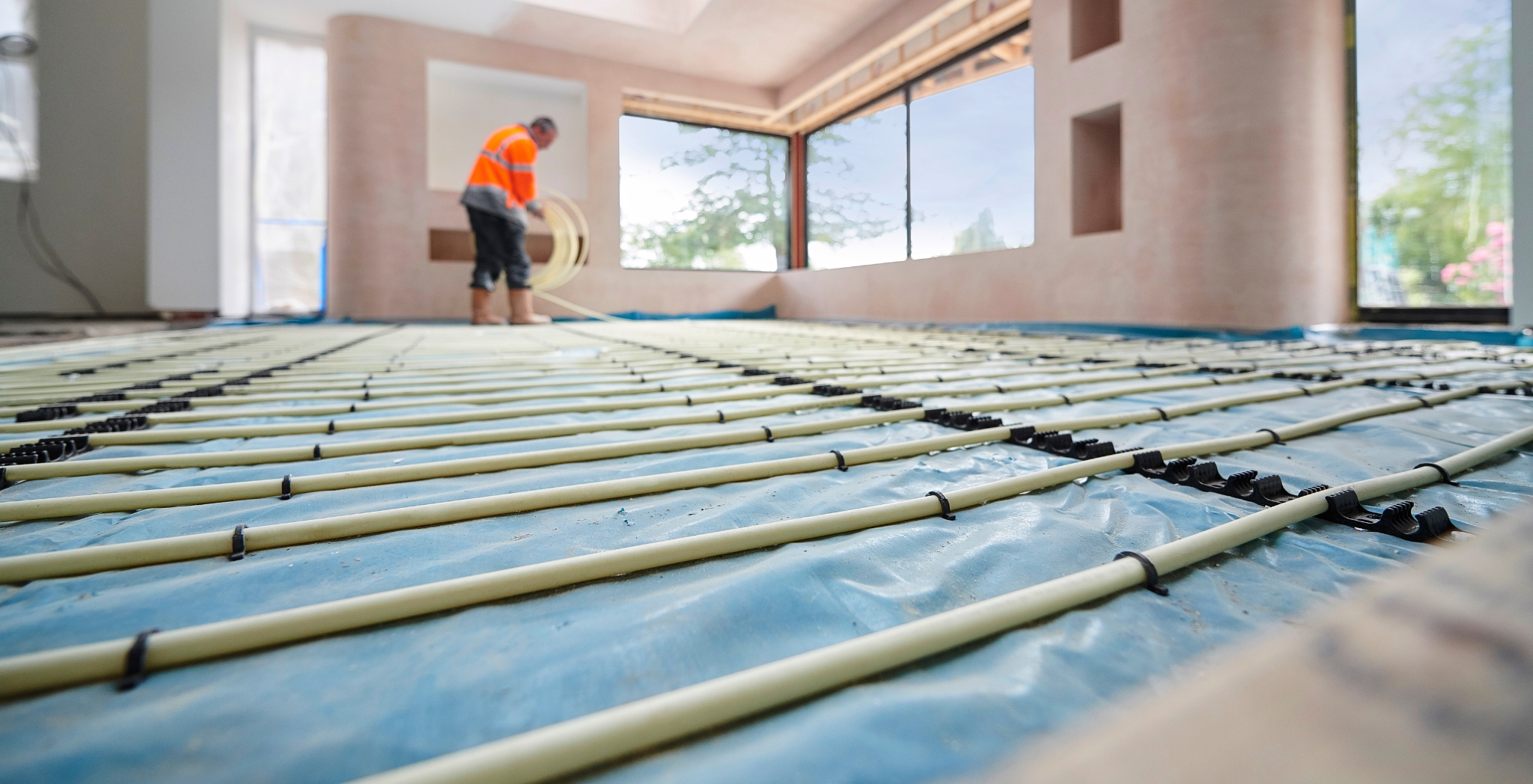
Are you tired of cold floors and high heating bills? Underfloor heating might be the solution for you!
This comprehensive guide will explore the workings of underfloor heating, the different types available, and their advantages and disadvantages.
How Does Underfloor Heating Work?
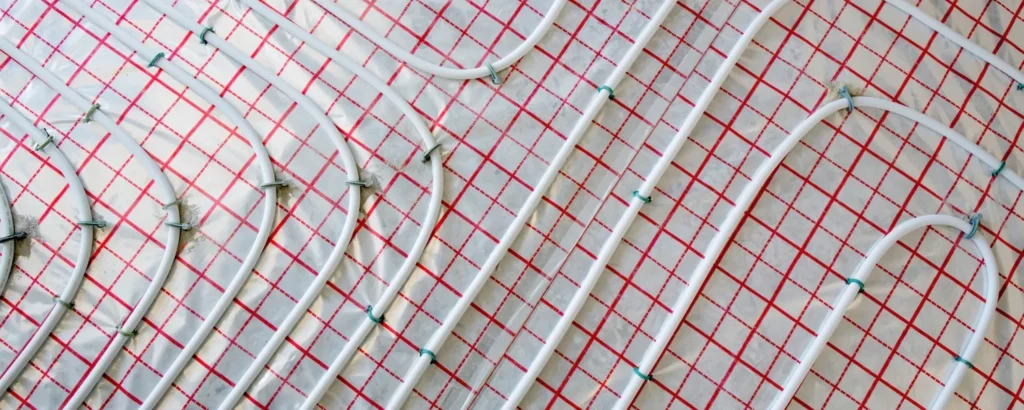
Underfloor heating uses heating elements installed beneath the floor surface to emit heat.
Depending on the type of underfloor heating system, these elements can be electrical cables or water-filled pipes.
When electricity flows through the wires, or warm water moves through the pipes, it heats the floor.
This warmth radiates upwards, heating the room evenly from the ground up.
The heat from underfloor heating systems is distributed more evenly than traditional radiators, creating a comfortable and cozy living space.
Electric or Water Underfloor Heating?
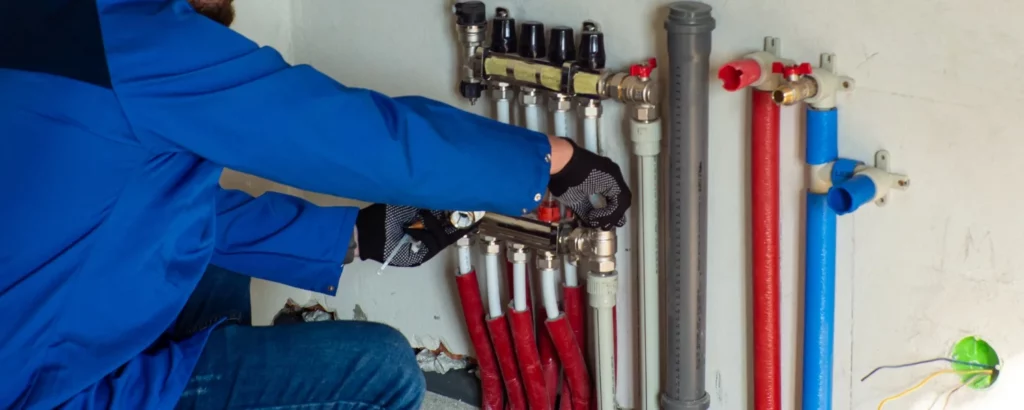
When choosing between Electric or Water Underfloor Heating, it’s crucial to consider cost, efficiency, installation requirements, and compatibility with your home’s heating system.
Electric heating systems use electrical cables or mats installed beneath the floor to generate warmth.
These infloor heating systems are usually simpler and cheaper to install than water-based ones, so many people prefer them for smaller areas or when renovating.
Electric underfloor heating systems offer a distinct advantage over other heating systems. They can respond quickly to temperature changes and provide individual room control through thermostats.
On the other hand, water-based systems, also known as hydronic systems, rely on a network of water-filled pipes installed beneath the floor.
These pipes are connected to a central heating system, such as Viessmann boilers, which circulates hot water to provide heat.
Despite their higher initial costs and more complex installation processes, water-based systems can be a wise investment in the long run.
Their energy efficiency and cost-effectiveness are significant advantages, especially in larger spaces or new constructions.
Deciding between electric and water-based systems depends on what you need, how much you want to spend, and what you like.
Electric systems may be ideal if you prioritize ease of installation, responsiveness, and individual room control.
However, if energy efficiency, long-term savings, and compatibility with existing heating systems are paramount, water-based systems could be the better option.
Regardless of the chosen type, both systems offer the benefits of even heat distribution, compatibility with various floor finishes such as laminate, and the potential to integrate with renewable energy sources like heat pumps.
Ultimately, it would help if you decided based on thinking carefully about what your home needs for heating.
Electric Underfloor Heating Systems
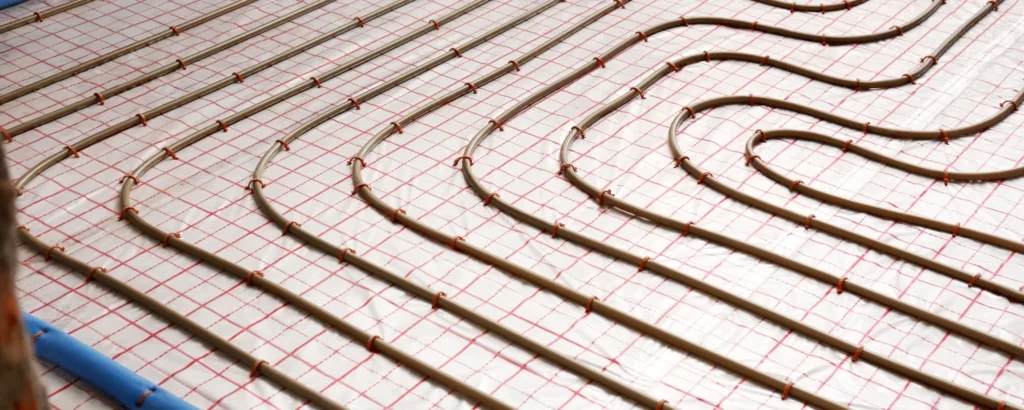
Electric underfloor heating systems are popular due to their ease of use and effectiveness in various settings.
These systems, which consist of electrical cables or heating mats installed beneath the floor, provide efficient and reliable warmth.
These systems use electrical cables or mats laid evenly beneath the floor finish, such as tiles, laminate, or wood.
When electricity flows through these elements, they generate heat, warming the floor above.
Installation typically requires the expertise of professionals, such as those from maple plumbing and heating, to ensure safety and effectiveness.
They carefully lay out the heating elements according to the floor plan and connect them to a thermostat to control the temperature.
One key advantage of these systems is their compatibility with various floor finishes, making them suitable for different types of flooring, including laminate and wood.
Unlike hydronic systems, electric ones can be easily retrofitted into existing homes without extensive plumbing work.
When combined with Viessmann or Viessman boilers, these solutions can provide efficient and sustainable home heating.
These boilers work seamlessly with the electric setup to ensure optimal performance and energy efficiency.
Electric systems offer a reliable and effective way to warm your home, providing even heat distribution and comfort throughout the space.
Proper installation and maintenance can enhance the ambiance of your living environment while reducing energy consumption and costs.
Electric underfloor heating – How it works:
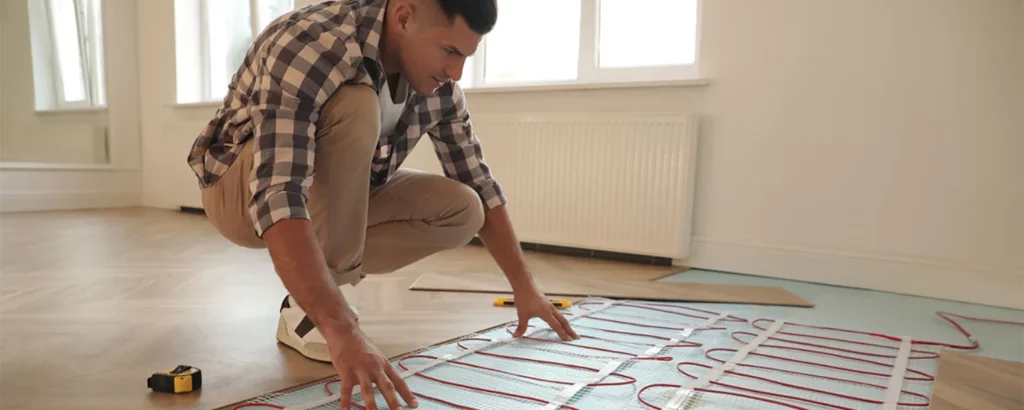
Electric underfloor heating uses electrical cables or mats installed beneath the floor surface to generate heat.
These heating elements are linked to an electrical power source and managed by an underfloor heating thermostat.
The process begins with installing the heating elements beneath the floor finish, such as tiles, laminate, or wood.
The cables or mats are evenly spaced to ensure uniform heat distribution throughout the room.
Once installed, electricity is supplied to the heating elements, causing them to generate heat.
As electricity passes through the cables or mats, they resist the flow of electrical current, converting electrical energy into heat energy.
This heat is then transferred to the floor surface, warming it up. The warmth radiates upwards, heating the room from the ground level.
An underfloor heating thermostat can control the temperature of the floor and the room, allowing for precise adjustments to suit individual preferences.
Some thermostats even offer programmable features, allowing users to set heating schedules based on their daily routines.
One key advantage of underfloor heating is its responsiveness to temperature changes.
Unlike traditional radiators, which can take time to heat up or cool down, electric underfloor heating systems can quickly adjust to changes in temperature, providing comfortable warmth when needed.
Electric underfloor heating systems are compatible with various floor finishes, making them suitable for almost any flooring material.
They are also relatively easy to install, particularly in retrofit projects or smaller spaces.
Electric underfloor heating is an efficient and effective way to heat your home, providing comfortable warmth and even heat distribution throughout the room.
It allows you to control temperatures precisely and is compatible with various floor finishes, making it a popular choice for modern homes.
Electric underfloor heating installation
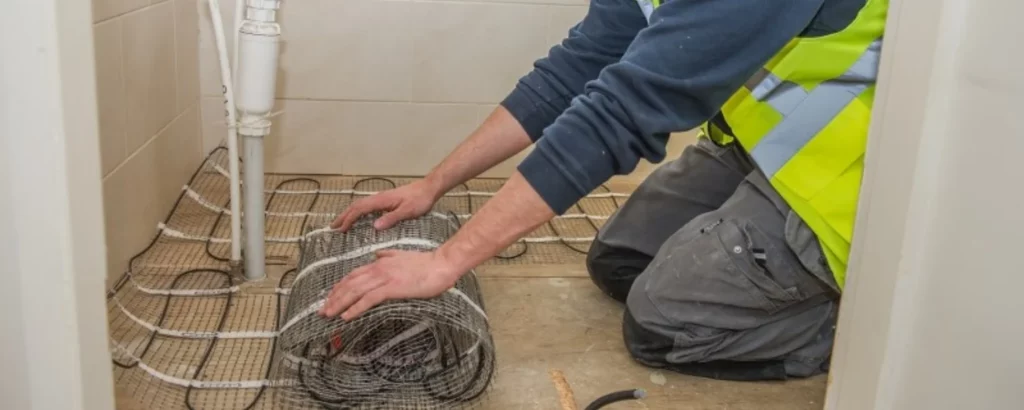
Installing electric underfloor heating involves a few essential steps to ensure it works well and is safe.
Here’s a simple overview of what happens during the installation:
1. Planning and Design: Planning and designing everything carefully is essential before installing your underfloor heating system.
Consider factors such as the room’s size, the type of flooring, and any obstacles that may affect the installation process.
Determine the layout of the heating elements to ensure even heat distribution throughout the room.
2. Preparation: Clear the room of any furniture or obstacles to provide access to the floor surface.
Ensure that the subfloor is clean, level, and free of debris. Make any repairs or adjustments to the subfloor before proceeding with installation.
3. Installation of Heating Elements: Depending on the type of electric underfloor heating system chosen, install heating cables or mats according to the manufacturer’s instructions.
Lay the heating elements evenly across the floor surface, maintaining proper spacing between each component to ensure uniform heat distribution.
4. Connection to Power Supply: Once the heating elements are installed, connect them to the electrical power supply.
Follow the manufacturer’s guidelines and local electrical codes to ensure safe and proper wiring.
To avoid any electrical hazards, use a qualified electrician for this step.
5. Testing: Before proceeding with the final flooring installation, test the electric underfloor heating system to ensure it functions correctly.
Check for any defects or malfunctions and address them promptly.
6. Flooring Installation: Once the heating system has been tested and confirmed working, install the final flooring material.
This can include tiles, laminate, wood, or other suitable flooring options. Follow the manufacturer’s installation guidelines to ensure compatibility with the underfloor heating system.
7. Thermostat Installation: Conveniently install the underfloor heating thermostat within the room.
This device allows for temperature control and heating scheduled programming.
Follow the manufacturer’s instructions for installation and programming.
8. Final Checks: After finishing the installation, double-check everything to ensure everything works correctly.
Test the thermostat and heating system to verify proper operation. Make any necessary adjustments or repairs.
Benefits of using underfloor heating with heat pumps
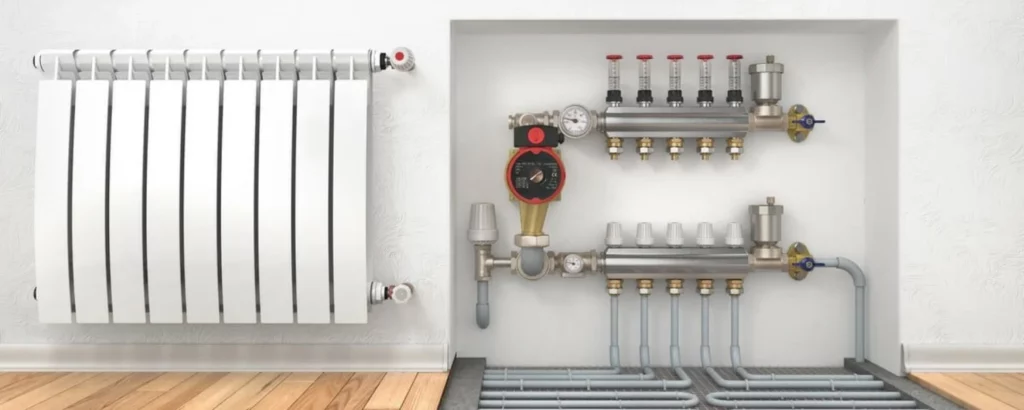
Pairing underfloor heating with heat pumps offers several benefits, enhancing efficiency and sustainability while providing optimal home comfort.
1. Energy Efficiency: Heat pumps are super-efficient heaters using renewable energy from the ground or air to warm your home.
Combined with underfloor heating, they maximize energy efficiency by harnessing natural resources, reducing reliance on fossil fuels, and lowering carbon emissions.
2. Cost Savings: Underfloor heating with heat pumps can significantly reduce energy consumption and lower heating costs compared to traditional heating methods by utilizing renewable energy sources.
Heat pumps operate efficiently, converting a small amount of energy into a large amount of heat, resulting in lower utility bills over time.
3. Even Heat Distribution: Underfloor heating systems distribute heat evenly throughout the room, eliminating cold spots and ensuring consistent warmth from floor to ceiling.
This even heat distribution is enhanced when paired with heat pumps, providing a comfortable living environment without bulky radiators or forced-air systems.
4. Compatibility with Renewable Energy: Underfloor heating with heat pumps is compatible with renewable energy sources, making it an environmentally friendly heating solution.
This synergy aligns with sustainable living practices and reduces your home’s carbon footprint.
5. Year-Round Comfort: Underfloor heating with heat pumps provides efficient heating during the colder months and offers cooling capabilities during the summer.
Heat pumps can operate in reverse during warmer weather, extracting heat from your home and transferring it outside, keeping your living space comfortable year-round.
6. Quiet Operation: Heat pumps operate quietly compared to traditional heating systems, providing a peaceful and comfortable environment for your home.
This silent operation enhances your living space’s comfort and enjoyment without disruptive noise from heating equipment.
7. Long-Term Investment: Investing in underfloor heating with heat pumps is a long-term investment in your home’s comfort and energy efficiency.
With the proper setup and upkeep, these systems can provide dependable heating and cooling for a long time.
Pairing underfloor heating with heat pumps offers numerous benefits, including energy efficiency, cost savings, heat distribution, compatibility with renewable energy, year-round comfort, quiet operation, and long-term investment value.
This setup offers a green and cozy heating option for today’s houses by using renewable energy and improving heating technology.
Disadvantages of Underfloor Heating

While underfloor heating has many benefits, it’s essential to think about some possible downsides before putting it in your home:
1. Installation Costs: Installing underfloor heating might cost more than setting up traditional heating systems.
This is especially true for water-based underfloor heating, which may require extensive plumbing work and professional installation.
2. Retrofitting Challenges: Retrofitting underfloor heating into existing buildings can be challenging and costly.
It often involves lifting and replacing flooring, disrupting your living space, and adding to the project’s overall expense.
3. Flooring Constraints: Certain flooring materials may not be suitable for use with underfloor heating.
For example, thick carpets or materials with poor heat conductivity may inhibit heat transfer from the underfloor heating system, reducing its effectiveness.
4. Warm-Up Time: Underfloor heating systems typically take longer to warm up than traditional radiators or forced-air systems.
This means that it may take longer for the room to reach the desired temperature after the heating system is turned on.
5. Maintenance Requirements: While underfloor heating systems generally require less maintenance than traditional heating systems, they can still be prone to leaks or electrical faults.
Regular maintenance checks are essential to ensure the system keeps working well.
6. Limited Zoning Control: Zoning control allows you to independently adjust the temperature of individual rooms or areas of your home.
While underfloor heating systems can be zoned, the level of control may be more limited compared to traditional heating systems with separate radiators or thermostats for each room.
7. Incompatibility with Certain Flooring Types: Some flooring materials, such as certain types of hardwood or laminate, may not be compatible with underfloor heating due to concerns about expansion and contraction.
It’s essential to consult with an expert installer to determine the suitability of your chosen flooring material.
8. Potential for Overheating: Improper installation or usage of underfloor heating systems can lead to overheating, which may damage the flooring or other components of the system.
Following manufacturer guidelines and seeking professional installation is crucial to prevent such issues.
While these disadvantages are worth considering, many homeowners find that the benefits of underfloor heating outweigh the potential drawbacks.
Conclusion
Whether electric or water-based, underfloor heating systems offer a modern and efficient solution for keeping your home warm and cozy.
Underfloor heating distributes heat evenly throughout the space, creating a comfortable environment for you and your family.
However, consulting with professionals like Life Mechanical is crucial to ensure proper installation and compatibility with your chosen flooring material.
With their expertise and knowledge, you can rest assured that your underfloor heating system will provide optimal performance and comfort for years.
Trust Life Mechanical for all your heating needs and transform your living space into a haven of warmth and relaxation.
Source: Underfloor Heating
- Get link
- X
- Other Apps
Comments
Post a Comment